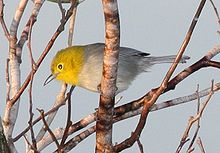| Cuban warblers[1] | |
|---|---|

| |
| Yellow-headed warbler (Teretistris fernandinae) | |
| Scientific classification | |
| Domain: | Eukaryota |
| Kingdom: | Animalia |
| Phylum: | Chordata |
| Class: | Aves |
| Order: | Passeriformes |
| Superfamily: | Emberizoidea |
| Family: | Teretistridae Baird 1864 |
| Genus: | Teretistris Cabanis, 1855 |
| Species | |
|
See text | |

The Cuban warblers are a genus, Teretistris, and family, Teretistridae, of birds endemic to Cuba and its surrounding cays. Until 2002 they were thought to be New World warblers, but DNA studies have shown that they are not closely related to that family. The family consists of two species, the yellow-headed warbler and the Oriente warbler. Both species are found in forest and scrub, with the yellow-headed warbler ranging in the west of the island and the Oriente warbler in the east. The Cuban warblers are 13 cm (5.1 in) long and have similar yellow and grey plumage.
The Cuban warblers are insectivores, with beetles forming a large part of the diet. Small reptiles and fruit are also taken. They feed in bushes and trees, in pairs or in small flocks during the non-breeding season, and are often the nucleus species for mixed-species feeding flocks with other birds, particularly migrants from North America.